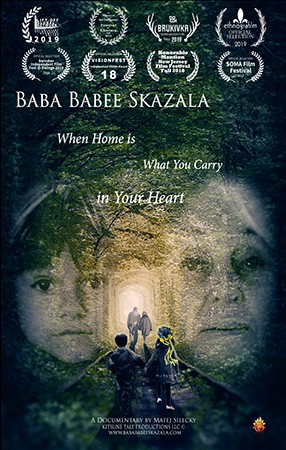
Baba Babee Skazala (Grandmother Told Grandmother) 2018
Distributed by Kitsune Tale Productions LLC
Produced by Julie Parker
Directed by Matej Silecky
Streaming, 69 mins
College - General Adult
Genocide; Immigration; World War II
Date Entered: 08/04/2020
Reviewed by Alan Witt, Business Librarian, SUNY GeneseoBaba Babee Skazala is a moving and heart wrenching documentary telling the stories of multiple Ukrainian-Americans who were displaced from their homeland during World War II. The film jumps frequently from viewpoint to viewpoint, cycling through their interviews as the timeline moves from occupation and displacement, through time in displaced persons camps, to immigration to the United states.
Stylistically, the film is effective, underscoring visuals with Ukranian music while leaving interviews sans music to emphasize the words of the subjects. Visuals used include still photos in black and white or color, live wartime footage, maps, and animatics. The animatics are the one place where the style falters; in a documentary depicting lived experiences (including live video footage of corpses crawling with flies), it was jarring to switch to still dramatizations where obviously photoshopped images move haltingly at each other. It detracted from the emotional impact of some horrific moments. Apart from that specific aspect, the film was very effective in its use of visuals and music.
Baba Babee Skazala is most effective in highlighting the individuality of the people it interviews while still showing the similarities in their experience. Rather than obviously grasping for an overarching narrative, the stories are left to stand on their own with supporting information and some context provided by a professor of political science. This makes the film flow very naturally, as the viewer is captured by each person’s humanity.
With that said, the film’s strength is also its weakness in an educational context: it is most effective when viewed in its entirety, with the narrative emerging from the whole rather than from any one part. With a runtime of 70 minutes, this would be a difficult film to use in the classroom, absent an extended class time. It is also not designed to be chopped up and clipped for context, as each individual experience in the film is woven expertly with the others to tell the story. As a course reserve or homework for viewing, however, this could be an excellent addition to a collection, as well as for any library building collections on immigration, Ukraine, Diaspora communities in the U.S., or World War II.
Awards:
Honorable Mention for Best Documentary at the New Jersey International Festival